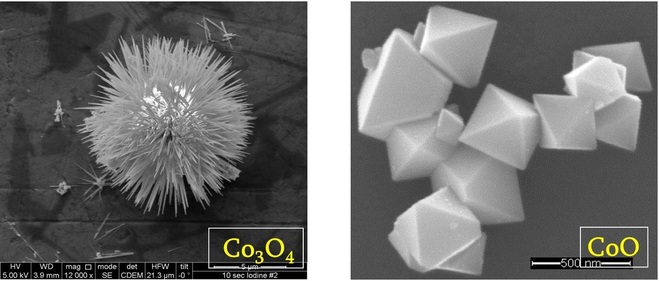Size, Shape & Morphology Controlled Nanocatalysis
Nanomaterials are one of those discoveries that have recently been developed to limits that scientists would have never dreamt of a century ago. The focus of this project is on “Size, Shape and Morphology Controlled Nanocatalysis”. We propose to design and synthesize, range of shape and morphology controlled nanomaterials (silica, metals, oxides, MOFs). We will then probe their activities for various important catalytic reactions like C-H activation, oxidation, hydrogenation, hydrogenolysis, CO2 capture-conversion to fine chemicals, and environmental remediation. To address some of the key challenges of catalytic technologies outlined above, this projects specific objective is developing new nanomaterial-based catalyst that exhibit improved activity and reduced mass transfer limitations. A guiding hypothesis is that access to highly reactive catalytic sites can be controlled by varying shape and morphology of nanomaterials.
Results from this research will advance the development of practical and sustainable nano-catalytic technologies. Results from the work will add to our fundamental understanding of dependence of activity and selectivity of nano-catalyst on its shapes and exposed facets. The insight gained from these structural studies can be then exploited to further improve the catalyst systems through the concept of “catalyst-by-design”. In addition, research results will also help to overcome practical issues related to the deployment of catalyst technologies for various challenging reactions such as C-H activation, oxidation, hydrogenation, hydrogenolysis, and environmental remediation including CO2 capture and conversion to fine chemicals. Although nano-catalytic technologies have often been shown to be very promising under idealized laboratory conditions, success of these approaches at industry scale has been limited due to stability of the catalyst. To overcome these limitations, it is critical that we develop both preventative and regenerative strategies for improving catalyst longevity and sustainability. We anticipate that the novel nanostructure supports developed in this project will help us begin to understand how to tailor catalyst support and active site structures to enhance its catalytic activity as well as stability. It is our expectation that the proposed research will significantly improve the performance and longevity of nano-catalysts and help for the development of catalytic processes as next generation technologies.
Some of the examples are given below;
Results from this research will advance the development of practical and sustainable nano-catalytic technologies. Results from the work will add to our fundamental understanding of dependence of activity and selectivity of nano-catalyst on its shapes and exposed facets. The insight gained from these structural studies can be then exploited to further improve the catalyst systems through the concept of “catalyst-by-design”. In addition, research results will also help to overcome practical issues related to the deployment of catalyst technologies for various challenging reactions such as C-H activation, oxidation, hydrogenation, hydrogenolysis, and environmental remediation including CO2 capture and conversion to fine chemicals. Although nano-catalytic technologies have often been shown to be very promising under idealized laboratory conditions, success of these approaches at industry scale has been limited due to stability of the catalyst. To overcome these limitations, it is critical that we develop both preventative and regenerative strategies for improving catalyst longevity and sustainability. We anticipate that the novel nanostructure supports developed in this project will help us begin to understand how to tailor catalyst support and active site structures to enhance its catalytic activity as well as stability. It is our expectation that the proposed research will significantly improve the performance and longevity of nano-catalysts and help for the development of catalytic processes as next generation technologies.
Some of the examples are given below;
Related Publications
1. Synthesis of single-crystal micro-pine structured nano-ferrites and their application in catalysis.
Vivek Polshettiwar, M. N. Nadaguada and R. S. Varma, Chem. Commun. 2008, 6318-6320.
2. Self-assembly of metal oxides into 3D nano-structures: Synthesis and nano-catalysis.“TOP 5 paper”
Vivek Polshettiwar,* Babita Baruwati, and R. S. Varma, ACS Nano 2009, 3, 728-736.
3. Self-assembly of palladium (Pd) nanoparticles: Synthesis of Pd nanobelts, nanoplates and nanotrees using vitamin B1 and their application in carbon-carbon coupling reactions.
M. N. Nadaguada, Vivek Polshettiwar, and R. S. Varma, J. Mat. Chem. 2009, 19, 2026–2031.
4. Fabrication of Hierarchical Anatase TiO2 Nanostructures with Unusual Control of Exposed Facets and Their Enriched Photocatalytic Activity.
Raed Rahal, Atul Wankhade, Dongkyu Cha, Aziz Fihri, Samy Ould-Chikh, Umesh Patil and Vivek Polshettiwar,* RSC Advance, 2012, 2, 7048-7052.
5. Nano-Roses of Nickel Oxides: MW-Assisted Green Synthesis, Electron Tomography Study, and Their Applications in CO Oxidation and Energy Storage.
A. Fihri, R. Sougrat, R. R. Baby, R. Rahal, D. Cha, M. Hedhili, M. Bouhrara, H. N. Alshareef, and Vivek Polshettiwar,*
ChemSusChem 2012, 5, 1241-1248.
6. Nano Ferrites for Water Splitting: Unprecedentedly High Photocatalytic H2 Production under Visible Light.
P. A. Mangrulkar, Vivek Polshettiwar,* R. S. Varma, S. S. Rayalu,* Nanoscale, 2012, 4, 5202-5209.
7. Nano cobalt oxides for photocatalytic hydrogen production.
P. A. Mangrulkar, M. M. Joshi, S.N Tijare, Vivek Polshettiwar, N. K. Labhsetwar, S. S. Rayalu,
Int. J. Hydrogen Energy, 2012, 37, 10462-10466.
8. Shape- and Morphology-Controlled Sustainable Synthesis of Cu, Co, and In Metal Organic Frameworks with High CO2 Capture Capacity.
P. Sarwade, H.Tan and Vivek Polshettiwar,*
ACS Sustainable Chemistry and Engineering, 2013, 1, 66-74. (IF: 4.64)
9. The Size- and Shape-Controlled Synthesis of Monodisperse Hexagonal Bipyramidal Crystals and Self-Assembled Hollow Spheres of an
Aluminum Metal Organic Framework & Their Hysteretic CO2 Capture Behaviour.
Pradip Sarawade, Hua Tan, D. Anjum, D. Cha, Vivek Polshettiwar,*
ChemSusChem, 2014, 7, 529-535. (IF): 7.475)
10. Facile and Sustainable Synthesis of Shaped Iron Oxide Nanoparticles: Effect of Iron Precursor Salts on the Shape of Iron Oxide.
Farheen Sayed and Vivek Polshettiwar*
Scientific Reports (by NATURE), 2015, 5, 9733. (IF: 5.078)
Vivek Polshettiwar, M. N. Nadaguada and R. S. Varma, Chem. Commun. 2008, 6318-6320.
2. Self-assembly of metal oxides into 3D nano-structures: Synthesis and nano-catalysis.“TOP 5 paper”
Vivek Polshettiwar,* Babita Baruwati, and R. S. Varma, ACS Nano 2009, 3, 728-736.
3. Self-assembly of palladium (Pd) nanoparticles: Synthesis of Pd nanobelts, nanoplates and nanotrees using vitamin B1 and their application in carbon-carbon coupling reactions.
M. N. Nadaguada, Vivek Polshettiwar, and R. S. Varma, J. Mat. Chem. 2009, 19, 2026–2031.
4. Fabrication of Hierarchical Anatase TiO2 Nanostructures with Unusual Control of Exposed Facets and Their Enriched Photocatalytic Activity.
Raed Rahal, Atul Wankhade, Dongkyu Cha, Aziz Fihri, Samy Ould-Chikh, Umesh Patil and Vivek Polshettiwar,* RSC Advance, 2012, 2, 7048-7052.
5. Nano-Roses of Nickel Oxides: MW-Assisted Green Synthesis, Electron Tomography Study, and Their Applications in CO Oxidation and Energy Storage.
A. Fihri, R. Sougrat, R. R. Baby, R. Rahal, D. Cha, M. Hedhili, M. Bouhrara, H. N. Alshareef, and Vivek Polshettiwar,*
ChemSusChem 2012, 5, 1241-1248.
6. Nano Ferrites for Water Splitting: Unprecedentedly High Photocatalytic H2 Production under Visible Light.
P. A. Mangrulkar, Vivek Polshettiwar,* R. S. Varma, S. S. Rayalu,* Nanoscale, 2012, 4, 5202-5209.
7. Nano cobalt oxides for photocatalytic hydrogen production.
P. A. Mangrulkar, M. M. Joshi, S.N Tijare, Vivek Polshettiwar, N. K. Labhsetwar, S. S. Rayalu,
Int. J. Hydrogen Energy, 2012, 37, 10462-10466.
8. Shape- and Morphology-Controlled Sustainable Synthesis of Cu, Co, and In Metal Organic Frameworks with High CO2 Capture Capacity.
P. Sarwade, H.Tan and Vivek Polshettiwar,*
ACS Sustainable Chemistry and Engineering, 2013, 1, 66-74. (IF: 4.64)
9. The Size- and Shape-Controlled Synthesis of Monodisperse Hexagonal Bipyramidal Crystals and Self-Assembled Hollow Spheres of an
Aluminum Metal Organic Framework & Their Hysteretic CO2 Capture Behaviour.
Pradip Sarawade, Hua Tan, D. Anjum, D. Cha, Vivek Polshettiwar,*
ChemSusChem, 2014, 7, 529-535. (IF): 7.475)
10. Facile and Sustainable Synthesis of Shaped Iron Oxide Nanoparticles: Effect of Iron Precursor Salts on the Shape of Iron Oxide.
Farheen Sayed and Vivek Polshettiwar*
Scientific Reports (by NATURE), 2015, 5, 9733. (IF: 5.078)






